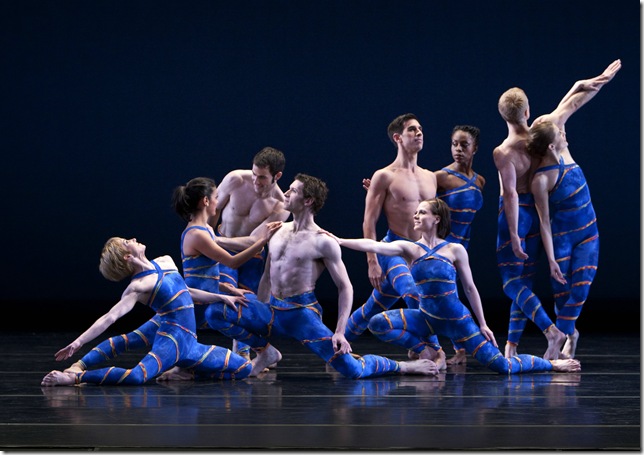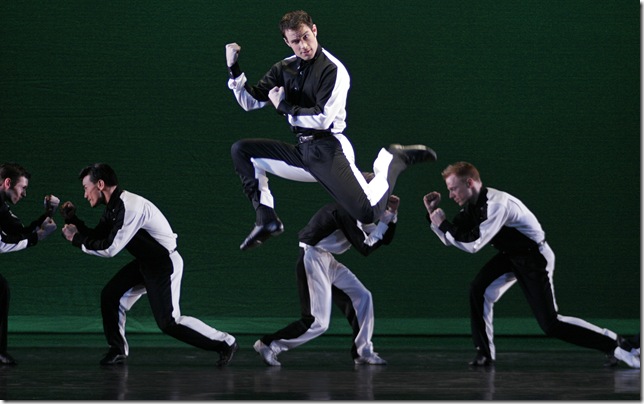By Tara Mitton Catao
The Paul Taylor Company returned to the Duncan Theatre in Lake Worth on Friday night, presenting three works that encompassed the range and variety of the great master choreographer who founded the troupe.
From dark to light, from humorous interpretation to pure dance movement, the program was drawn from Taylor’s repertory of the 139 dances he has created over his long and prolific career. However, the program Friday night, in contrast to the outstanding performance given two years ago at the Duncan, just didn’t take off.
There is a certain expectation one has when one come to see the works of a great choreographer like Taylor performed by the dancers he has chosen to work with, choreographs for and interacts with on a daily basis.
One of the joys of watching a Taylor work is enjoying his craftsmanship as one’s eye is enticed to follow one dancer only to be replaced by another even more enticing. Taylor weaves the dancers’ bodies in and out of complex, almost-architectural, designs, leaving us anticipating and hoping that each dancer will come around again. With few exceptions, that just didn’t happen.
Taylor’s choreography is crafted to utilize the personality and idiosyncrasies of each dancer, and perhaps it is difficult for the repertory when the original dancer is no longer in the company. Perhaps it is a like fracture that is hard to heal. It could be that more often one sees his most popular works danced in ballet companies. There, one misses seeing the abandon and grounded quality of his movement in the ballet dancers but then, when one see his company and his dancers doing his movements, one misses the clarity and beautiful lines we saw in the ballet dancers.
First up on the program and choreographed in 2004 was Dante’s Variations, which was inspired by a verse in the Inferno. It was choreographed to music by György Ligeti adapted for barrel organ, which gave a strange carnival aspect to an otherwise un-carnival mood. It was a dark and surprisingly un-engaging piece about the “uncommitted” souls in
Hell who had done neither good nor evil in life — an odd choice to be first on program.
Eran Bugge and Michael Trusnovec stood out in this work, first in each of their individual solos as they observed each other, and then in their duet together with their focus locked as they circled in bizarre lighting that painted just their bare feet a freakish green. Bugge is a compact and grounded dancer who moved with clarity and intent. Trusnovec, buff, bare-chested and blond, resonated onstage with a confidence and elegance that few of the dancers could match.
The nostalgic Funny Papers, choreographed in 1994, is dedicated to those people who read the comics (the funnies) before they read the newspaper. Light, frothy merriment was served up as the performers danced to novelty tunes in front of a brightly lit background which was saturated with comic book primary colors and designed by Jennifer Tipton.
With the exception of Francisco Graciano, who etched a clear character giving depth to his solo in I Am Woman, the performance was lackluster. The casual movement was missing clarity and commitment and was dulled by a generic merriment and overshadowed by the visual effect of the flipping of colors as the dancers moved wearing costumes designed by Santo Loquasto which had alternating black-and-white fronts and backs.
Closing the program was Mercuric Tidings, which was choreographed in 1982 and is one of Taylor’s signature works. This large work for 13 dancers highlighted his affinity to classical music and his mastery in translating musical composition into a visual weave of movement. Using excerpts from the first two symphonies of Franz Schubert and his recognized palette of movements, Taylor created a work that begged to have a lot of space to take off and soar. The Duncan Theatre stage, so excellent for viewing dance, seemed small as the dancers maneuvered competently around each other with exceptional speed but somehow they never quite soared.
The eye gravitated once again to Trusnovec as he wove his floor patterns with precision and his elegant partner Laura Halzack. One wished for other charismatic energies onstage to further enrich the design of the choreography and drive Mercuric Tidings into the stratosphere.
No doubt there is an expectation of seeing greatness on all levels when going to see the dance company of an iconic choreographer such as Paul Taylor. This performance was solid and competent, but it just didn’t ignite.
The next program in the Duncan Theatre’s dance series features Pilobolus, which will appear at 8 p.m. Friday and Saturday Feb. 14 and 15. Both performances are sold out. For more information, call 868-3309.

